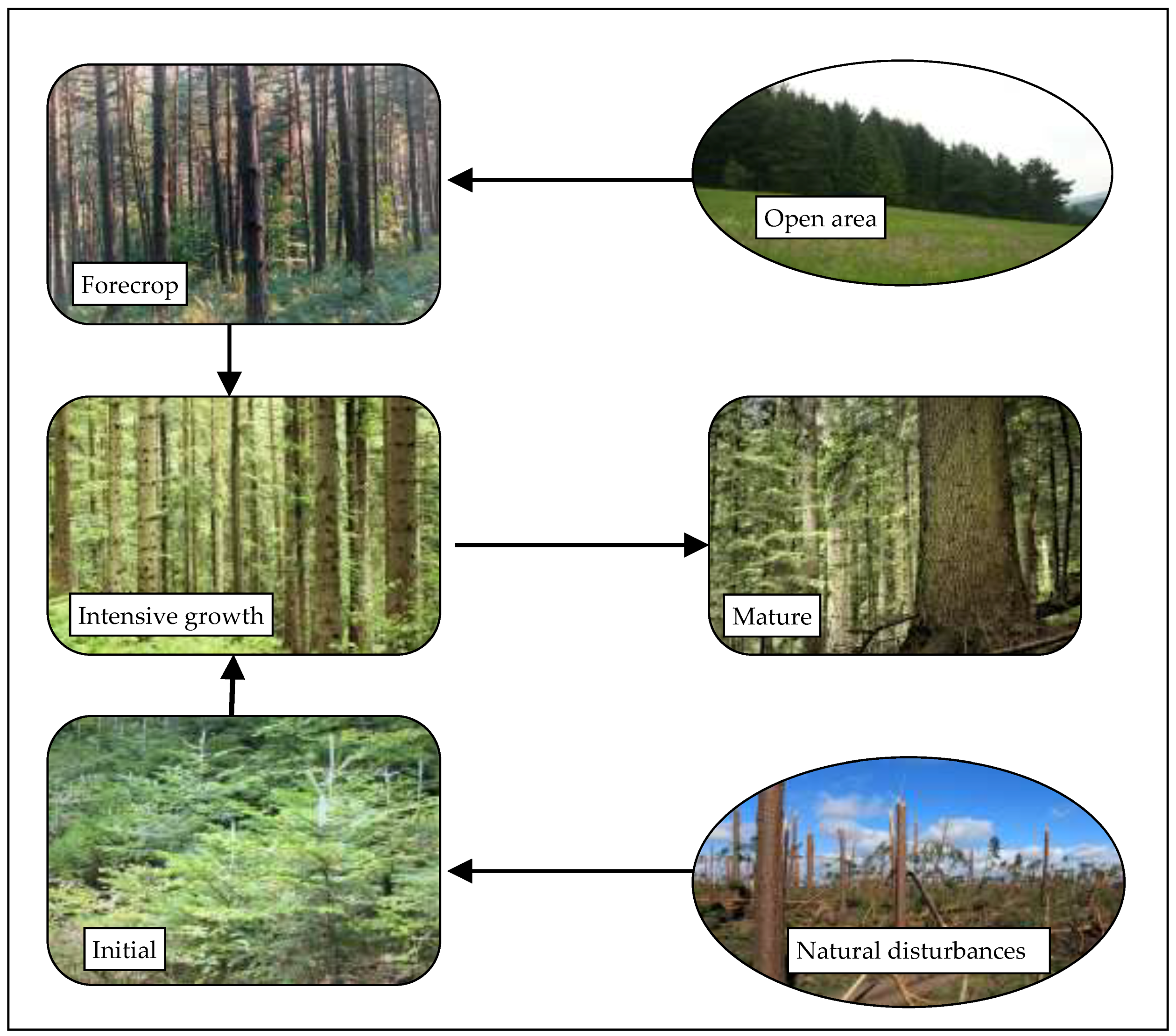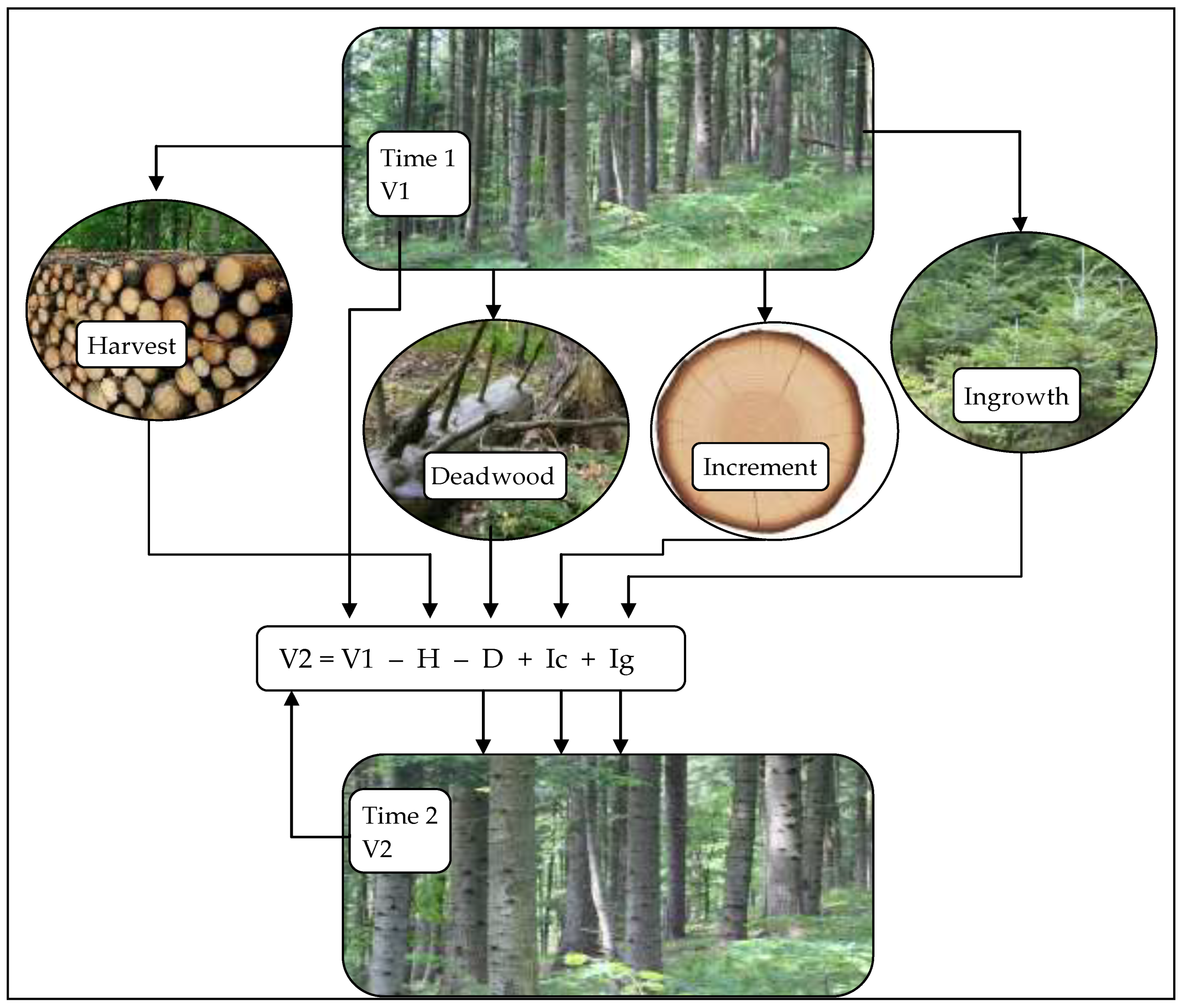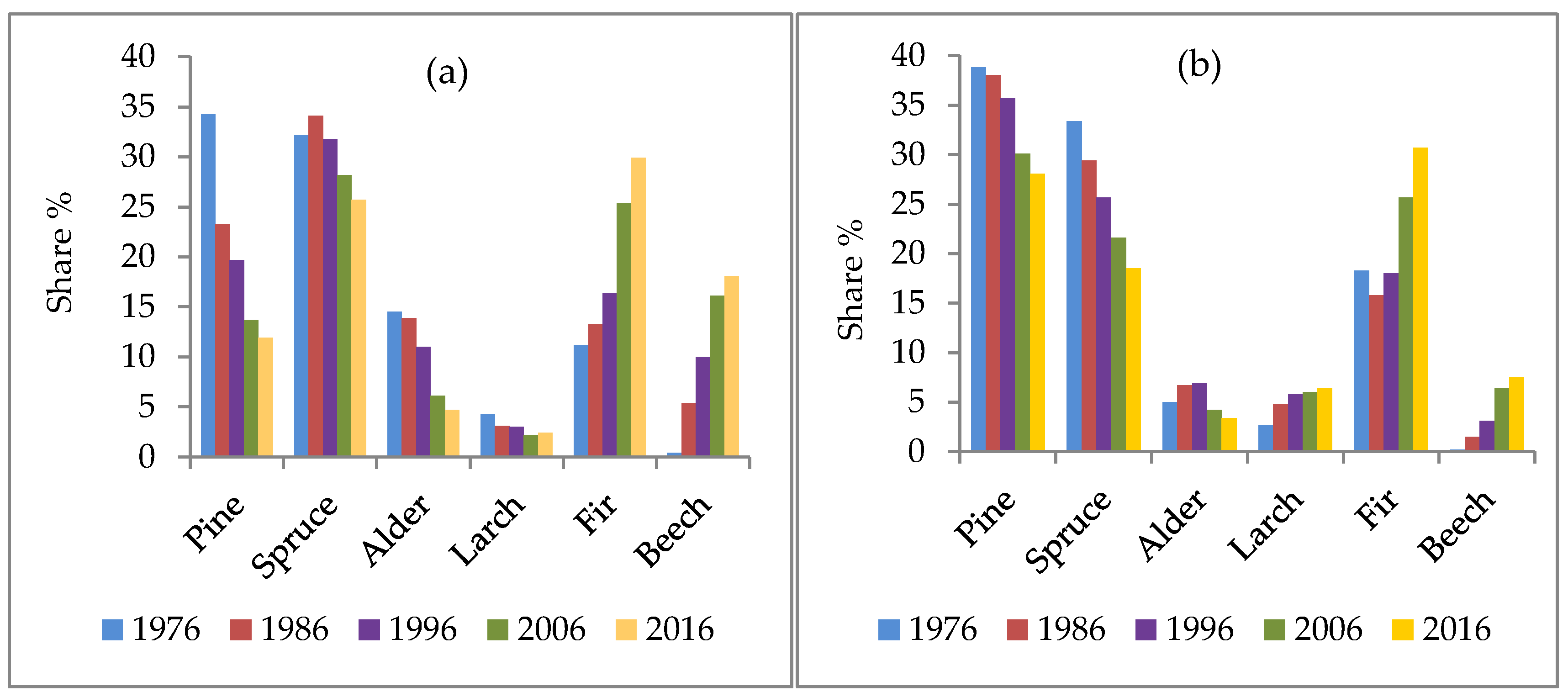An Example of Uneven-Aged Forest Management for Sustainable Timber Harvesting
Abstract
1. Introduction
2. Materials and Methods
2.1. Uneven-Aged Forest Model
- The initial phase (I) corresponds to young stands with trees below the merchantable size (DBH < 7 cm). They mostly derive from natural regeneration in open areas; planted regeneration is less frequent. In uneven-aged stands managed by complex silvicultural systems with long regeneration periods (exceeding 40 years), initial phase stands are very rare, predominantly resulting from adverse events such as windthrows, fires, fungal infection, or pest damage, which effectively remove the tree layer from a given area. Uneven-aged forests may have an initiation phase that begins with small gaps.
- The intensive growth phase (G) is characterized by a large number of stems per unit of area; most of the trees have low DBH values (7–34 cm) and intensively increase in volume. Under favourable conditions, understory regeneration may occur. In uneven-aged stands after transition period intensive growth phase occurs also rare, similar as initial phase.
- The mature growth phase (M) describes tree stands with a considerable proportion of large older trees characterized by a volume increment that is lower than that in the intensive growth phase. Trees with a DBH of above 34 cm constitute at least 60% of the stand volume. The natural regeneration in gaps is produced.
- The forecrop phase (F) describes stands established on non-forest areas using pioneer tree species like birch, Scots pine, grey alder and larch. The main functions of forecrop stands is creating shelter for target species such as fir and beech. Forecrop stands are considered fully transformed when the volume of target species appropriate for the site amounts to at least 70% of the overall stand volume.
- A stand is deemed pure if the dominant tree species accounts for at least 80% of the overall volume. Such stands are named after the prevalent species, for example, fir, beech, spruce and so forth.
- Two-species stands consist of two tree species which individually account for 30–70% of the total. Here stand names include both species in descending order of abundance, for example, fir-beech, spruce-fir and so forth.
- Multi-species stands are those in which the less abundant species jointly account for more than 20% of the stand with only one species in the 30–70% range. In this case, stand names are usually formed by preceding the prevalent species with the descriptor “mixed” (e.g., mixed fir stand).
2.2. Development Processes in Uneven-Aged Forests
2.3. Studied Forest
2.4. Measurements and Calculations
3. Results
3.1. Tree Stand Characteristics
3.2. Harvest Volume
3.3. Growing Stock Changes
4. Discussion and Conclusions
- The implementation of close-to-nature silviculture improved the quality and volume of growing stock over the 40-year study period. The species composition of the stands revealed an increase in the target species of silver fir and beech and a decline in the forecrop species as well as in species not suited for mountain forest sites, such as Scots pine, Norway spruce and grey alder. The species diversity of the stands as measured with the Shannon index progressed from 0.70 in 1976 to 0.81 in 2016.
- The stand structure and growing stock revealed a considerable improvement. Between 1976 and 2016 the mean growing stock volume almost doubled from 147 to 284 m3, while the percentage share of mature stands rose from 19% to 28% of the forest area.
- The progress in volume increment from 6.89 to 10.72 in the years 1976–2016 resulted from favourable changes in the species and age structure of the stands as well as from the general rising trend observed in European forests in that period.
- In the first measurement period (1976–1986) the harvesting intensity was low at 2.16 m3/ha/year and gradually increased over time with increases in growing stock volume, volume increment and the percentage share of mature phase stands, to reach 10.34 m3/ha/year in the 2006–2016 period.
Supplementary Materials
Author Contributions
Funding
Acknowledgments
Conflicts of Interest
References
- Heinonen, T.; Pukkala, T.; Mehtätalo, L.; Asikainen, A.; Kangas, J.; Peltola, H. Scenario analyses for the effects of harvesting intensity on development of forest resources, timber supply, carbon balance and biodiversity of Finnish forestry. For. Policy Econ. 2017, 80, 80–98. [Google Scholar] [CrossRef]
- Burton, P.J.; Messier, C.; Adamowicz, W.L.; Kuuluvainen, T. Sustainable management of Canada’s boreal forests: Progress and prospects. Écoscience 2006, 13, 234–248. [Google Scholar] [CrossRef]
- Montreal Process Working Group Criteria and Indicators for the Conservation and Sustainable Management of Temperature and Boreal Forests. Available online: http://www.montrealprocess.org/ (accessed on 18 March 2018).
- Sarkar, A.U. Sustainability, sustainable development and forest resources. Int. J. Sustain. Dev. World Ecol. 1998, 5, 164–171. [Google Scholar] [CrossRef]
- Vierikko, K.; Vehkamäki, S.; Niemelä, J.; Pellikka, J.; Lindén, H. Meeting the ecological, social and economic needs of sustainable forest management at a regional scale. Scand. J. For. Res. 2008, 23, 431–444. [Google Scholar] [CrossRef]
- Diaci, J.; Firm, D. Long-term dynamics of a mixed conifer stand in Slovenia managed with a farmer selection system. For. Ecol. Manag. 2011, 262, 931–939. [Google Scholar] [CrossRef]
- Schütz, J.P.; Saniga, M.; Diaci, J.; Vrška, T. Comparing close-to-nature silviculture with processes in pristine forests: Lessons from Central Europe. Ann. For. Sci. 2016, 73, 911–921. [Google Scholar] [CrossRef]
- Bončina, A.; Klopčič, M.; Simončič, T.; Dakskobler, I.; Ficko, A.; Rozman, A. A general framework to describe the alteration of natural tree species composition as an indicator of forest naturalness. Ecol. Indic. 2017, 77, 194–204. [Google Scholar] [CrossRef]
- Buongiorno, J. Quantifying the implications of transformation from even to uneven-aged forest stands. For. Ecol. Manag. 2001, 151, 121–132. [Google Scholar] [CrossRef]
- Schütz, J.P. Opportunities and strategies of transforming regular forests to irregular forests. For. Ecol. Manag. 2001, 151, 87–94. [Google Scholar] [CrossRef]
- Sterba, H. Equilibrium curves and growth models to deal with forests in transition to uneven-aged structure—Application in two sample stands. Silva Fenn. 2004, 38, 413–423. [Google Scholar] [CrossRef]
- Diaci, J.; Kerr, G.; O’Hara, K. Twenty-first century forestry: Integrating ecologically based, uneven-aged silviculture with increased demands on forests. Forestry 2011, 84, 463–465. [Google Scholar] [CrossRef]
- Brang, P.; Spathelf, P.; Larsen, J.B.; Bauhus, J.; Bončína, A.; Chauvin, C.; Drössler, L.; García-Güemes, C.; Heiri, C.; Kerr, G.; et al. Suitability of close-to-nature silviculture for adapting temperate European forests to climate change. Forestry 2014, 87, 492–503. [Google Scholar] [CrossRef]
- Spathelf, P.; Bolte, A.; Van der Maaten, E. Is Close-to-Nature Silviculture (CNS) an adequate concept to adapt forests to climate change? Landbauforsch Appl. Agric. For. Res. 2015, 3–4, 161–170. [Google Scholar] [CrossRef]
- Schütz, J.P. Close-to-nature silviculture: Is this concept compatible with species diversity? Forestry 1999, 72, 359–366. [Google Scholar] [CrossRef]
- Miścicki, S. Using developmental stages of forest stands as a basis for forest inventory. Sylwan 1994, 4, 29–39. (In Polish) [Google Scholar]
- Král, K.; McMahon, S.M.; Janík, D.; Adam, D.; Vrška, T. Patch mosaic of developmental stages in central European natural forests along vegetation gradient. For. Ecol. Manag. 2014, 330, 17–28. [Google Scholar] [CrossRef]
- Lorimer, C.G.; Halpin, C.R. Classification and dynamics of developmental stages in late-successional temperate forests. For. Ecol. Manag. 2014, 334, 344–357. [Google Scholar] [CrossRef]
- Winter, S.; Brambach, F. Determination of a common forest life cycle assessment method for biodiversity evaluation. For. Ecol. Manag. 2011, 262, 2120–2132. [Google Scholar] [CrossRef]
- O’Hara, K.L. Multiaged Silviculture: Managing for Complex Stand Structures; Oxford University Press: Oxford, UK, 2014. [Google Scholar]
- Meyer, H.A. Management without rotation. J. For. 1943, 41, 126–132. [Google Scholar]
- Raymond, P.; Bédard, S.; Roy, V.; Larouche, C.; Tremblay, S. The irregular shelterwood system: Review, classification and potential application to forests affected by partial disturbances. J. For. 2009, 107, 405–413. [Google Scholar] [CrossRef]
- Gurnaud, A. La Sylviculture Française et la Méthode du Controle; Imprimerie Paul Jacquin: Besançon, France, 1886. (In French) [Google Scholar]
- Biolley, H.E. L’aménagement des Forêts par la Méthode Expérimentale et Spécialement la Méthode du Controle; Attinger: Paris, France, 1920. (In French) [Google Scholar]
- Zingg, A.; Frutig, F.; Bürgi, A.; Lemm, R.; Erni, V.; Bachofen, H. Ertragskundliche Leistung in den Plenterwald-Versuchsflächen der Schweiz | Yield performance in the plenter forest research plots in Switzerland. Schweiz. Z. Forstwes. 2009, 160, 162–174. [Google Scholar] [CrossRef]
- Przybylska, K. Survey of forest resources in the period 1974–1981 in the “Las pod Huzarami” in Krynica. Sylwan 1987, 7, 15–24. (In Polish) [Google Scholar]
- Rutkowski, B. Forest management in period 1975–1984 and its results in the Szczawiczne forest in the aspect of projected implementation of natural line in silviculture. Acta Agric. Silv. Ser. Silv. 1988, 27, 133–143. (In Polish) [Google Scholar]
- Czuraj, M. Volume Tables of Standing Trees; PWRiL: Warsaw, Poland, 1990. (In Polish) [Google Scholar]
- Banaś, J. Stand-level inventory and control method for uneven-aged forests. Sylwan 2005, 11, 18–24. (In Polish) [Google Scholar]
- Bobiec, A.; Van Der Burgt, H.; Meijer, K.; Zuyderduyn, C.; Haga, J.; Vlaanderen, B. Rich deciduous forests in Bialowieza as a dynamic mosaic of developmental phases: Premises for nature conservation and restoration management. For. Ecol. Manag. 2000, 130, 159–175. [Google Scholar] [CrossRef]
- Emborg, J.; Christensen, M.; Heilmann-Clausen, J. The structural dynamics of Suserup Skov, a near-natural temperate deciduous forest in Denmark. For. Ecol. Manag. 2000, 126, 173–189. [Google Scholar] [CrossRef]
- Oliver, C.D. Forest development in North America following major disturbances. For. Ecol. Manag. 1981, 3, 153–168. [Google Scholar] [CrossRef]
- Oliver, C.D.; Larson, B.C. Forest Stand Dynamics, Update Edition; John Wiley& Sons: New York, NY, USA, 1996. [Google Scholar]
- O’Hara, K.L. What is close-to-nature silviculture in a changing world? Forestry 2016, 89, 1–6. [Google Scholar] [CrossRef]
- Schütz, J.P. Silvicultural tools to develop irregular and diverse forest structures. Forestry 2002, 75, 329–337. [Google Scholar] [CrossRef]
- Bončina, A. History, current status and future prospects of uneven-aged forest management in the Dinaric region: An overview. Forestry 2011, 85, 467–478. [Google Scholar] [CrossRef]
- De Liocourt, F. De l’amenagement des sapinières. Bull. Trimest. Soc. For. Res. Franche-Comte Belfort 1898, 4, 396–409. (In French) [Google Scholar]
- Schϋtz, J.P. Der Plenterbetrieb; Fachbereich Waldbau: Zϋrich, Switzerland, 1989. (In German) [Google Scholar]
- Agnoletti, M.; Santoro, A. Cultural values and sustainable forest management: The case of Europe. J. For. Res. 2015, 20, 438–444. [Google Scholar] [CrossRef]
- Carey, A.B.; Lippke, B.R.; Sessions, J. Intentional System Management: Managing forest for biodiversity. J. Sustain. For. 1999, 9, 83–125. [Google Scholar] [CrossRef]




| Stand Group No. | Area (ha) | Species Composition Category 1 | Development Phase 2 | Stand Volume (m3/ha) | Number of Trees | Species Diversity Shannon Index | |||||
|---|---|---|---|---|---|---|---|---|---|---|---|
| 1976 | 2016 | 1976 | 2016 | 1976 | 2016 | 1976 | 2016 | 1976 | 2016 | ||
| 1 | 31.2 | ESF-NS | ESF mix | G | M | 117 | 331 | 677 | 528 | 0.44 | 0.54 |
| 2 | 79.6 | NS mix | ESF mix | G | G | 171 | 251 | 697 | 689 | 0.48 | 0.63 |
| 3 | 5.95 | ESF | ESF | G | M | 131 | 449 | 738 | 677 | 0.27 | 0.39 |
| 4 | 18.03 | SP-NS | ESF-SP | G | M | 160 | 288 | 750 | 710 | 0.51 | 0.64 |
| 5 | 40.86 | NS-SP | NS-ESF | G | G | 140 | 229 | 630 | 674 | 0.45 | 0.64 |
| 6 | 11.95 | ESF mix | SF mix | G | M | 129 | 247 | 937 | 547 | 0.74 | 0.58 |
| 7 | 7.84 | SP | SP mix | M | M | 230 | 280 | 472 | 696 | 0.32 | 0.57 |
| 8 | 6.56 | NS-ESP | NS-ESF | M | M | 228 | 421 | 940 | 567 | 0.37 | 0.30 |
| 9 | 25.01 | ESP | ESF | M | G | 224 | 294 | 1082 | 608 | 0.31 | 0.30 |
| 10 | 17.17 | SP-NS | NS mix | M | M | 131 | 301 | 446 | 833 | 0.53 | 0.77 |
| 11 | 30.98 | SP mix | ESF mix | M | M | 174 | 250 | 655 | 920 | 0.47 | 0.58 |
| 12 | 26.96 | EL-SP | EL-SP | F | F | 120 | 360 | 1371 | 546 | 0.44 | 0.76 |
| 13 | 25.67 | GAR mix | SP mix | F | F | 99 | 316 | 1364 | 638 | 0.52 | 0.96 |
| 14 | 21.59 | SP-NS | NS mix | F | F | 112 | 195 | 1063 | 482 | 0.61 | 0.64 |
| 15 | 70.26 | SP mix | SP mix | F | F | 126 | 281 | 1260 | 765 | 0.57 | 0.88 |
| 16 | 36.23 | NS-SP | SP mix | F | F | 132 | 337 | 1336 | 676 | 0.57 | 0.79 |
| Total/Average | 455.86 | – | – | – | – | 147 | 284 | 932 | 678 | 0.70 | 0.81 |
| Development Phase | 1976–1986 | 1986–1996 | 1996–2006 | 2006–2016 | Mean |
|---|---|---|---|---|---|
| Forecrop | 9.78 | 10.52 | 10.70 | 10.71 | 10.43 |
| Intensive growth | 5.19 | 8.47 | 8.16 | 10.62 | 7.98 |
| Mature | 4.54 | 7.61 | 8.46 | 10.83 | 8.20 |
| Average | 6.89 | 9.16 | 9.21 | 10.72 | 8.99 |
| Development Phase | 1976–1986 | 1986–1996 | 1996–2006 | 2006–2016 | Mean |
|---|---|---|---|---|---|
| Forecrop | 1.57 | 4.73 | 8.84 | 11.64 | 6.70 |
| Intensive growth | 2.41 | 4.23 | 5.77 | 9.05 | 5.15 |
| Mature | 2.76 | 4.59 | 3.27 | 11.12 | 7.36 |
| Average | 2.16 | 4.48 | 6.83 | 10.34 | 6.12 |
| Development Phase | 1976–1986 | 1986–1996 | 1996–2006 | 2006–2016 | Mean |
|---|---|---|---|---|---|
| % Increment/% Growing Stock | |||||
| Forecrop | 16.1/1.3 | 45.0/2.3 | 82.7/3.4 | 108.7/4.3 | 63.1/2.8 |
| Intensive growth | 46.4/1.6 | 50.0/2.4 | 70.7/2.7 | 85.2/3.8 | 61.7/2.6 |
| Mature | 60.8/1.5 | 60.3/2.2 | 38.7/1.4 | 102.7/3.9 | 86.4/2.7 |
| Average | 31.0/1.5 | 48.9/2.3 | 74.2/2.9 | 96.4/3.9 | 65.2/2.8 |
© 2018 by the authors. Licensee MDPI, Basel, Switzerland. This article is an open access article distributed under the terms and conditions of the Creative Commons Attribution (CC BY) license (http://creativecommons.org/licenses/by/4.0/).
Share and Cite
Banaś, J.; Zięba, S.; Bujoczek, L. An Example of Uneven-Aged Forest Management for Sustainable Timber Harvesting. Sustainability 2018, 10, 3305. https://doi.org/10.3390/su10093305
Banaś J, Zięba S, Bujoczek L. An Example of Uneven-Aged Forest Management for Sustainable Timber Harvesting. Sustainability. 2018; 10(9):3305. https://doi.org/10.3390/su10093305
Chicago/Turabian StyleBanaś, Jan, Stanisław Zięba, and Leszek Bujoczek. 2018. "An Example of Uneven-Aged Forest Management for Sustainable Timber Harvesting" Sustainability 10, no. 9: 3305. https://doi.org/10.3390/su10093305
APA StyleBanaś, J., Zięba, S., & Bujoczek, L. (2018). An Example of Uneven-Aged Forest Management for Sustainable Timber Harvesting. Sustainability, 10(9), 3305. https://doi.org/10.3390/su10093305






